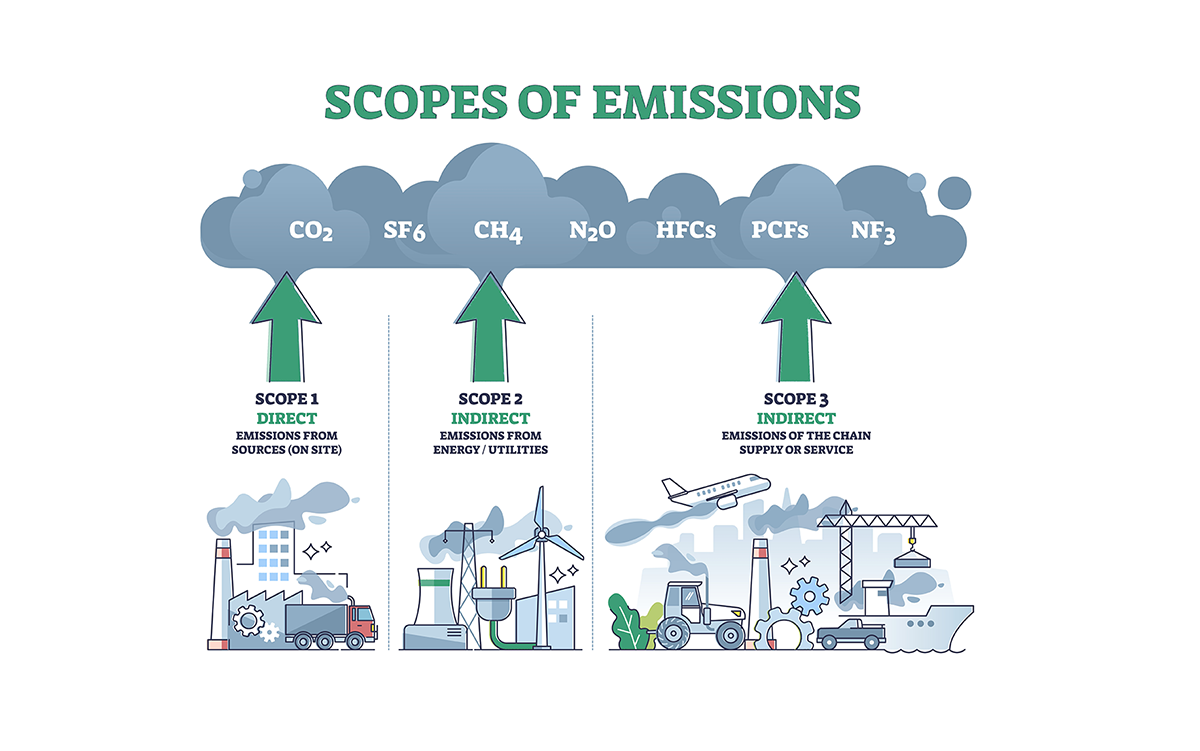Share article
Understanding the Greenhouse Gas Protocol and Scopes 1, 2 and 3
In today's environmentally conscious world, understanding the Greenhouse Gas Protocol scopes is crucial for any organization committed to sustainability.
Scope 1, Scope 2 and Scope 3 according to the GHG Protocol
This glossary explains the Greenhouse Gas Protocol ) and the three scopes associated with it, which empower businesses to not only understand but also effectively manage their environmental impact.
The GHG Protocol was first introduced in 1998 by the World Resources Institute, a global research non-profit organization. It is a framework focused on measuring and reporting by organizations of their greenhouse gas emissions. The GHG protocol is probably most well renowned for introducing the three-scope approach which has become a widely adopted standard for organizations to report their greenhouse gas emissions from their entire value chain, not only their own operations. This approach has been very influential as is evident by its incorporation into most relevant sustainability reporting standards that have followed it.
The three scopes as introduced by the GHG protocol are as follows:
Scope 1: Direct emissions from owned or controlled sources
Scope 1 emissions refer to direct greenhouse gas emissions that occur from sources that are owned or controlled by the reporting entity. Examples include combustion of fuels on-site, e.g. gasoline used in company-owned vehicles or oil burned in on-site furnaces. This also includes emissions from industrial processes that occur at the organization’s facilities.
Scope 1 emissions are under the direct control of the reporting organization and are often the most straightforward and simple to measure and manage. Companies know, or should be able to find out, how much fuel or other energy sources they consume and can convert those figures into CO2 equivalent by using the relevant coefficient.
Scope 2: Indirect Emissions from Energy Consumption
Scope 2 emissions include indirect greenhouse gas emissions associated with the generation of purchased or acquired electricity, heat, or steam consumed by the reporting entity. Examples include electricity, heat or steam purchased from utility companies or other external providers.
These emissions are indirect because they result from activities outside of the organization’s direct control but are still considered relevant to its operations. These emissions are best measured by gathering data directly from suppliers.
Organizations can, where available, choose to procure energy from renewable sources and can reduce their Scope 2 emissions.
Scope 3: Other indirect emissions - Broadening the Emission Perspective
Scope 3 emissions cover all indirect emissions that occur in a reporting organization’s value chain, apart from those covered by Scope 2.
This is commonly the most significant of the three scopes for reporting companies, especially for companies that produce products and rely on sourcing their materials from suppliers “upstream” and shipping and selling their products to consumers or other buyers "downstream". This can be hard to wrap your head around due in part to the fact that it’s hard to envision all emissions upstream and downstream at the same time. For this reason, the GHG protocol classifies scope 3 emissions into 15 categories:
- Purchased goods and services
- Capital goods
- Fuel- and energy-related activities
- Transportation and distribution (upstream)
- Transportation and distribution (downstream)
- Waste generated in operations
- Business travel
- Employee commuting
- Leased assets (upstream)
- Leased assets (downstream)
- Processing of sold products
- Use of sold products
- End-of-life treatment of sold products
- Franchises
- Investments
The 15 scope 3 categories entail a varying degree of difficulty to measure and quantify. Some of them are more straightforward. Waste generated in operations can be organized and physically measured. Employee commuting can be estimated by surveying employees. Upstream and downstream activities require communication with various stakeholders and assessment of information gathered.
The GHG protocol’s three scope approach provides a structured approach that helps businesses and other entities identify and manage emissions throughout their entire value chain, not just those directly under their operational control.
This approach has been influential in shaping corporate sustainability reporting standards and guidelines, enabling organizations to assess and communicate their environmental impact in a systematic manner. Many corporate sustainability reports and emissions inventories are structured around the three scopes defined by the GHG Protocol.
Share article
